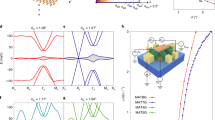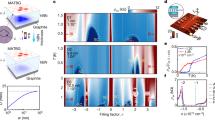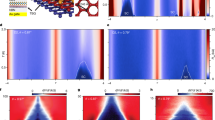Abstract
Superconductivity can occur under conditions approaching broken-symmetry parent states1. In bilayer graphene, the twisting of one layer with respect to the other at ‘magic’ twist angles of around 1 degree leads to the emergence of ultra-flat moiré superlattice minibands. Such bands are a rich and highly tunable source of strong-correlation physics2,3,4,5, notably superconductivity, which emerges close to interaction-induced insulating states6,7. Here we report the fabrication of magic-angle twisted bilayer graphene devices with highly uniform twist angles. The reduction in twist-angle disorder reveals the presence of insulating states at all integer occupancies of the fourfold spin–valley degenerate flat conduction and valence bands—that is, at moiré band filling factors ν = 0, ±1, ±2, ±3. At ν ≈ −2, superconductivity is observed below critical temperatures of up to 3 kelvin. We also observe three new superconducting domes at much lower temperatures, close to the ν = 0 and ν = ±1 insulating states. Notably, at ν = ± 1 we find states with non-zero Chern numbers. For ν = −1 the insulating state exhibits a sharp hysteretic resistance enhancement when a perpendicular magnetic field greater than 3.6 tesla is applied, which is consistent with a field-driven phase transition. Our study shows that broken-symmetry states, interaction-driven insulators, orbital magnets, states with non-zero Chern numbers and superconducting domes occur frequently across a wide range of moiré flat band fillings, including close to charge neutrality. This study provides a more detailed view of the phenomenology of magic-angle twisted bilayer graphene, adding to our evolving understanding of its emergent properties.
This is a preview of subscription content, access via your institution
Access options
Access Nature and 54 other Nature Portfolio journals
Get Nature+, our best-value online-access subscription
$29.99 / 30 days
cancel any time
Subscribe to this journal
Receive 51 print issues and online access
$199.00 per year
only $3.90 per issue
Buy this article
- Purchase on Springer Link
- Instant access to full article PDF
Prices may be subject to local taxes which are calculated during checkout




Similar content being viewed by others
Data availability
The data that support the findings of this study are available from the corresponding author upon reasonable request.
References
Lee, P. A., Nagaosa, N. & Wen, X.-G. Doping a Mott insulator: physics of high-temperature superconductivity. Rev. Mod. Phys. 78, 17 (2006).
Bistritzer, R. & MacDonald, A. H. Moire bands in twisted double-layer graphene. Proc. Natl Acad. Sci. USA 108, 12233–12237 (2011).
Cao, Y. et al. Correlated insulator behaviour at half-filling in magic-angle graphene superlattices. Nature 556, 80–84 (2018).
Chen, G. et al. Evidence of a gate-tunable Mott insulator in a trilayer graphene moiré superlattice. Nat. Phys. 15, 237–241 (2019).
Tarnopolsky, G., Kruchkov, A. J. & Vishwanath, A. Origin of magic angles in twisted bilayer graphene. Phys. Rev. Lett. 122, 106405 (2019).
Cao, Y. et al. Unconventional superconductivity in magic-angle graphene superlattices. Nature 556, 43–50 (2018).
Chen, G. et al. Signatures of gate-tunable superconductivity in trilayer graphene moiré superlattice. Nature 572, 215–219 (2019).
Kopnin, N., Heikkilä, T. & Volovik, G. High-temperature surface superconductivity in topological flat-band systems. Phys. Rev. B 83, 220503 (2011).
Sharpe, A. L. et al. Emergent ferromagnetism near three-quarters filling in twisted bilayer graphene. Science 365, 605–608 (2018).
Xie, M. & MacDonald, A. H. On the nature of the correlated insulator states in twisted bilayer graphene. Preprint at https://arxiv.org/abs/1812.04213 (2018).
Ochi, M., Koshino, M. & Kuroki, K. Possible correlated insulating states in magic-angle twisted bilayer graphene under strongly competing interactions. Phys. Rev. B 98, 081102 (2018).
Dodaro, J. F., Kivelson, S. A., Schattner, Y., Sun, X.-Q. & Wang, C. Phases of a phenomenological model of twisted bilayer graphene. Phys. Rev. B 98, 075154 (2018).
Thomson, A., Chatterjee, S., Sachdev, S. & Scheurer, M. S. Triangular antiferromagnetism on the honeycomb lattice of twisted bilayer graphene. Phys. Rev. B 98, 075109 (2018).
Nandkishore, R., Levitov, L. & Chubukov, A. Chiral superconductivity from repulsive interactions in doped graphene. Nat. Phys. 8, 158 (2012).
Cao, Y. et al. Strange metal in magic-angle graphene with near Planckian dissipation. Preprint at https://arxiv.org/abs/1901.03710 (2019).
Po, H. C., Zou, L., Senthil, T. & Vishwanath, A. Faithful tight-binding models and fragile topology of magic-angle bilayer graphene. Phys. Rev. B 99, 195455 (2019).
Kim, K. et al. Tunable moiré bands and strong correlations in small-twist-angle bilayer graphene. Proc. Natl Acad. Sci. USA 114, 3364–3369 (2017).
Yankowitz, M. et al. Tuning superconductivity in twisted bilayer graphene. Science 363, 1059–1064 (2019).
Cao, Y. et al. Superlattice-induced insulating states and valley-protected orbits in twisted bilayer graphene. Phys. Rev. Lett. 117, 116804 (2016).
Lian, B., Xie, F. & Bernevig, B. A. The Landau level of fragile topology. Preprint at https://arxiv.org/abs/1811.11786 (2018).
Song, Z. et al. All magic angles in twisted bilayer graphene are topological. Phys. Rev. Lett. 123, 036401 (2019).
Bultinck, N., Chatterjee, S. & Zaletel, M. P. Anomalous Hall ferromagnetism in twisted bilayer graphene. Preprint at https://arxiv.org/abs/1901.08110 (2019).
Zhang, Y.-H., Mao, D. & Senthil, T. Twisted bilayer graphene aligned with hexagonal boron nitride: anomalous Hall effect and a lattice model. Preprint at https://arxiv.org/abs/1901.08209 (2019).
Polshyn, H. et al. Phonon scattering dominated electron transport in twisted bilayer graphene. Preprint at https://arxiv.org/abs/1902.00763 (2019).
Kondo, T. et al. Quadratic Fermi node in a 3D strongly correlated semimetal. Nat. Commun. 6, 10042 (2015).
Kagawa, F., Itou, T., Miyagawa, K. & Kanoda, K. Magnetic-field-induced Mott transition in a quasi-two-dimensional organic conductor. Phys. Rev. Lett. 93, 127001 (2004).
Lian, B., Wang, Z. & Bernevig, B. A. Twisted bilayer graphene: a phonon driven superconductor. Phys. Rev. Lett. 122, 257002 (2019).
Wu, F., Hwang, E. & Sarma, S. D. Phonon-induced giant linear-in-T resistivity in magic angle twisted bilayer graphene: ordinary strangeness and exotic superconductivity. Phys. Rev. B 99, 165112 (2019).
Kim, K. et al. van der Waals heterostructures with high accuracy rotational alignment. Nano Lett. 16, 1989–1995 (2016).
Purdie, D. G. et al. Cleaning interfaces in layered materials heterostructures. Nat. Commun. 9, 5387 (2018).
Acknowledgements
We are grateful for discussions with P. Jarillo-Herrero, A. Bernevig, M. Yankowitz, A. Young, C. Dean, L. Levitov, A. Vishwanath, M. Fisher, M. Allan and F. Koppens. D.K.E. acknowledges support from the Ministry of Economy and Competitiveness of Spain through the ‘Severo Ochoa’ program for Centres of Excellence in R&D (SE5-0522), Fundació Privada Cellex, Fundació Privada Mir-Puig, the Generalitat de Catalunya through the CERCA program, the H2020 Programme under grant agreement number 820378, Project: 2D·SIPC and the La Caixa Foundation. A.H.M. and M.X. acknowledge support from Department of Energy grant DE-FG02-02ER45958 and Welch Foundation grant TBF1473. A.B. acknowledges support from the Plan Nacional (RTI2018-097953-B-I00) of MICINN. G.Z. acknowledges support from the National Science Foundation of China under grant numbers 11834017 and 61888102, and the Strategic Priority Research Program of the Chinese Academy of Sciences under grant number XDB30000000.
Author information
Authors and Affiliations
Contributions
D.K.E. and X.L. conceived and designed the experiments; X.L., W.Y. and P.S. performed the experiments; X.L. and D.K.E. analysed the data; M.X. and A.H.M. performed the theoretical modelling of the data; T.T. and K.W. contributed materials; D.K.E., A.B., M.A.A., I.D., C.U. and G.Z. supported the experiments; X.L., D.K.E., P.S., X.M. and A.H.M. wrote the paper.
Corresponding author
Ethics declarations
Competing interests
The authors declare no competing interests.
Additional information
Publisher’s note Springer Nature remains neutral with regard to jurisdictional claims in published maps and institutional affiliations.
Peer review information Nature thanks David Goldhaber-Gordon and the other, anonymous, reviewer(s) for their contribution to the peer review of this work.
Extended data figures and tables
Extended Data Fig. 1 Schematic of the stacking process for the fabrication of twisted bilayer graphene with graphite bottom gate.
a–h, Sequential device fabrication method, describing the tear-and-stack co-lamination process used to create the hBN/tBLG/hBN/graphite stacks.
Extended Data Fig. 2 Mechanical cleaning of twisted bilayer graphene.
a–d, Optical images of the final stacks before mechanical cleaning (a, c) and after mechanical cleaning (b, d).
Extended Data Fig. 3 Hall measurements of device D1.
Coloured vertical bars correspond to filling factors ν = −4, −2, 2 and 4. Hall charge carrier density (nH = −B/(eRxy)) closely follows the gate-induced carrier density n. Near charge neutrality, nH = n. Beyond the band insulator regions (ν = ±4), the Hall density strictly follows nH = n ± 4n0.
Extended Data Fig. 4 Measuring the homogeneity of the twist angle.
a–d, Atomic force microscopy images of a set of twisted bilayer graphene samples. Scale bar, 2 μm. Dashed-line arrows correspond to the height profiles shown below the topographies. e, f, Two-terminal conductance measurements taken between contacts shown in a and b. Colours correspond to the bars shown in a and b, respectively. The difference in carrier density between the CNP and the ν = 2 state is used to extract the local twist angle.
Extended Data Fig. 5 Four-terminal longitudinal resistance as a function of carrier density at different temperatures.
The four-terminal longitudinal resistance is plotted against carrier density n for different temperatures, from 69 K (black trace) to 16 mK (red trace). Coloured vertical bars correspond to the filling factors ν as shown.
Extended Data Fig. 6 Additional measurements of other possible superconducting domes.
a–d, Differential resistance measurements for additional domes between –4n0 and −3n0 (a), −2n0 and −n0 (b) 2n0 and 3n0 (c) and 3n0 and 4n0 (d). e–h, Corresponding thermal activation measurements of resistance against temperature for the same carrier densities as in a–d, respectively.
Extended Data Fig. 7 Full characterization of all four superconducting pockets in sample D1.
a–d, Thermal activation measurements of resistance against carrier density. The inset shows magnified images, demonstrating that in three superconducting states the resistance drops completely to zero (a, b, d) and in one superconducting state the resistance saturates at about 80 Ω (c). e–h, Differential resistance is plotted against d.c. bias current at various temperatures in order to establish BKT transition temperatures. i–l, Two-dimensional colour plots of the differential resistance as a function of magnetic field and excitation current at 16 mK.
Extended Data Fig. 8 Additional magnetic hysteresis data.
a, Four-terminal longitudinal resistance as a function of carrier density at different temperatures from 50 mK (black trace) to 5.2 K (red trace). b, c, Plots of longitudinal resistance Rxx and transverse resistance Rxy against magnetic field at different charge carrier densities and 100 mK. Arrows indicate the sweep direction of the magnetic field. Data from b is used to extract data for Fig. 4e. d, Transverse resistance plotted against magnetic field at different temperatures (the same dataset as in Fig. 4c). Dashed and solid lines correspond to ascending and descending magnetic fields, respectively.
Supplementary information
Supplementary Information
This file contains the Supplementary Information (sections A–I), which includes Supplementary Figures S1–S8
Rights and permissions
About this article
Cite this article
Lu, X., Stepanov, P., Yang, W. et al. Superconductors, orbital magnets and correlated states in magic-angle bilayer graphene. Nature 574, 653–657 (2019). https://doi.org/10.1038/s41586-019-1695-0
Received:
Accepted:
Published:
Issue Date:
DOI: https://doi.org/10.1038/s41586-019-1695-0
This article is cited by
-
Flat bands, strange metals and the Kondo effect
Nature Reviews Materials (2024)
-
Tunable quantum interferometer for correlated moiré electrons
Nature Communications (2024)
-
Disorder scattering in classical flat channel transport of particles between twisted magnetic square patterns
Communications Physics (2024)
-
Layer-polarized ferromagnetism in rhombohedral multilayer graphene
Nature Communications (2024)
-
Terahertz linear/non-linear anomalous Hall conductivity of moiré TMD hetero-nanoribbons as topological valleytronics materials
Scientific Reports (2024)
Comments
By submitting a comment you agree to abide by our Terms and Community Guidelines. If you find something abusive or that does not comply with our terms or guidelines please flag it as inappropriate.



